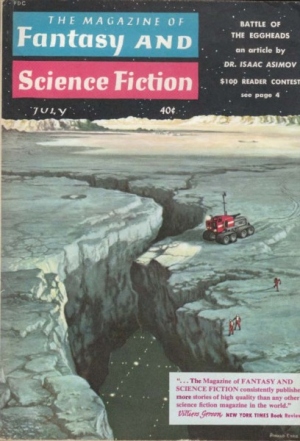Birthday Reviews: Avram Davidson’s “Author, Author”

Avram Davidson was born on April 23, 1923 and died on May 8, 1993. He served as the editor of The Magazine of Fantasy and Science Fiction from the April 1962 issue until November 1964. During that time, the magazine was nominated for three Hugos, winning one.
Davidson also won a Hugo for his short story “Or All the Seas with Oysters.” He was nominated for ten Nebula Awards, one of which was posthumous. He received nine World Fantasy Nominations, and won for Best Collection for The Enquiries of Doctor Eszterhazy, for Best Short Fiction for “Naples,” and a Lifetime Achievement Award in 1986. He also received posthumous nominations for the Seiun Award and the British Science Fiction Association Award.
“Author, Author” was published in the July 1959 issue of The Magazine of Fantasy of Science Fiction under the editorship of Robert P. Mills. Davidson reprinted it in his 1962 collection Or All the Seas with Oysters and it was published in the British edition of Venture Science Fiction in October 1964. Robert Silverberg and Grania Davis included it in The Avram Davidson Treasury.
Rodney Stirrup was the mystery author who invented the cliché “The butler did it” according to Davidson’s “Author, Author.” Unfortunately, his writing has become trite and predictable, leading his publisher to decide to cancel Stirrup’s contracts. Dejected, Stirrup heads into the country where his car breaks down and he goes to a nearby large mansion for help. Stirrup’s discovery that the large group of men congregating in the house know him takes a rather different turn when he learns it is essentially a butler convention.
Davidson has fun with the stereotypical elements of British cozy mysteries in “Author, Author” in a rather clever way. Stirrup is enough of a dislikable character that the reader has no problem with the various misfortunes that befall him. The story is light-hearted and Davidson seems to be having fun with the writing.
Reprint reviewed in the collection The Avram Davidson Treasury, by Avram Davidson, edited by Robert Silverberg and Grania Davis, Tor Books, 1998.
 Steven H Silver is a sixteen-time Hugo Award nominee and was the publisher of the Hugo-nominated fanzine Argentus as well as the editor and publisher of ISFiC Press for 8 years. He has also edited books for DAW and NESFA Press. He began publishing short fiction in 2008 and his most recently published story is “Doing Busines at Hodputt’s Emporium” in Galaxy’s Edge. Steven has chaired the first Midwest Construction, Windycon three times, and the SFWA Nebula Conference 5 times, as well as serving as the Event Coordinator for SFWA. He was programming chair for Chicon 2000 and Vice Chair of Chicon 7. He has been the news editor for SF Site since 2002.
Steven H Silver is a sixteen-time Hugo Award nominee and was the publisher of the Hugo-nominated fanzine Argentus as well as the editor and publisher of ISFiC Press for 8 years. He has also edited books for DAW and NESFA Press. He began publishing short fiction in 2008 and his most recently published story is “Doing Busines at Hodputt’s Emporium” in Galaxy’s Edge. Steven has chaired the first Midwest Construction, Windycon three times, and the SFWA Nebula Conference 5 times, as well as serving as the Event Coordinator for SFWA. He was programming chair for Chicon 2000 and Vice Chair of Chicon 7. He has been the news editor for SF Site since 2002.
Avram Davidson was indeed one of the true greats. Another F&SF story, “The Sources of the Nile”, is firmly on my list of the greatest SF stories of all time.
Paul McAuley and Naomi Kritzer would also have been good choices, but Davidson trumps them! And I suspect Howard Andrew Jones might have gone for Talbot Mundy!
Talbot Mundy? Paul McAuley? Naomi Kritzer and Avram Davidson? April 23 was an auspicious day for science fiction!